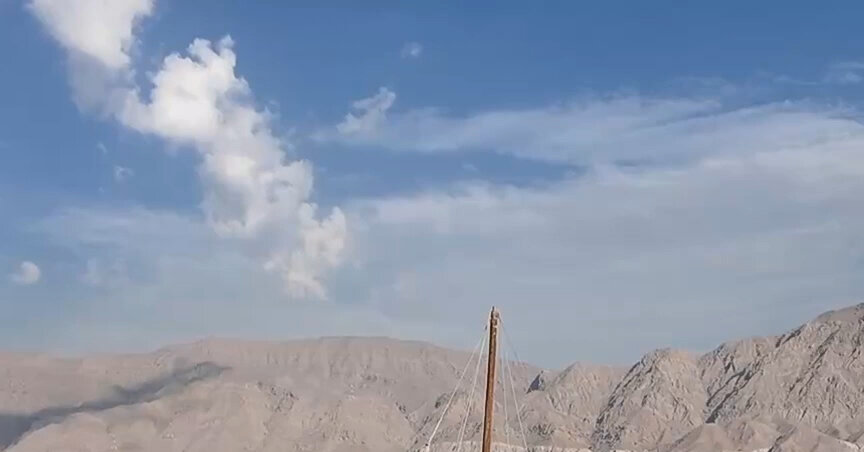Long before Abu Dhabi and Dubai sparkled with bright lights and soaring skyscrapers, their country, the United Arab Emirates, glowed with the luster of pearls.
For centuries, divers donned camel-skin finger guards, nose clips made from sheep bones and dark cotton suits to ward off sharks, plunging 15 to 30 feet below the surface of the Persian Gulf to harvest oysters. A thousand of them might yield just 10 pearls.
On a warm Saturday morning early this year, I stood aboard a wooden dhow just off the coast of Ras al Khaymah, the northernmost of the seven emirates that make up the United Arab Emirates. An opalescent blue haze softened the craggy spine of the Hajar Mountains in the distance.
“Welcome to what was once known as the Coast of Pearls,” said our guide, clad in an immaculate white head scarf, as we reached a pontoon at Suwaidi Pearl Farm, near the village of Al Rams.
He used a special pair of scissors to open an oyster and probed its interior with a small knife. To the delight of everyone on board, he gently extracted a beautiful, medium-size pearl.
I had come to this place to get away from the frenetic energy and almost alarming opulence of Dubai. During previous visits, I had found myself wondering what the country had been like before one of the largest and most sudden deluges of wealth and immigration in human history. Was there a way to find out? Everyone gave me the same answer: “Visit the other emirates.”
So I planned a one-week trip to Sharjah, Ajman, Al Fujayrah and Ras al Khaymah, four of the less developed, and less visited, emirates.
Sharjah
A Feeling of Authenticity
The emirates have always attracted business travelers, but until recently, they haven’t been quite as prominent on tourists’ radars. That may be changing: Overall tourist arrivals in Dubai alone were up 9 percent last year over the previous year. And later this year or in early 2026, the emirates plan to join six other Gulf states, including Qatar, Oman and Saudi Arabia, in a Schengen Area-like zone that requires just one visa, the G.C.C. Grand Tours Visa.
Dubai, a booming desert metropolis of nearly four million, has astonished me over and over on my visits. Still, I was relieved to exit the vast, neon-lit cacophony of its airport at 2 a.m. and get into a cab headed to Sharjah, about 40 minutes away, depending on traffic.
The driver, an Indian who was born in Uganda and had lived in Britain, expressed surprise at my destination. “Sharjah? Foreigners don’t go to Sharjah,” he said. Sharjah remains the only emirate that prohibits all alcohol consumption, which may contribute to that belief.
At the Chedi Al Bait hotel, a friendly Syrian man led me through a maze of dimly lit lanes among earthen brick buildings and riads with palm-tree-planted courtyards. The still night air smelled slightly salty, with whiffs of wood fire and ripe fruit. Even in darkness, Sharjah had a sense of place and an authenticity I’d almost never experienced in Dubai.
The next morning, in the Heart of Sharjah district, which is part of a heritage renovation project, the daylight revealed a mix of traditional, coral-walled buildings and modern shops along the tree-lined creek that serves as what’s left of the working port.
As in the other emirates, residents of Sharjah subsisted on fishing, trading and pearl diving before the early 1900s, when the rise of Japanese cultured pearls devastated the local industry and plunged many of the emirates into poverty until the discovery of oil in 1958. The United Arab Emirates’s population has since exploded to almost 11.5 million from just 92,000 in 1960, and the country has become one of the richest in the world.
Sultan bin Muhammad al-Qasimi, Sharjah’s ruler since 1999, has made art, culture and education keystones of this emirate’s modern identity, and it has many museums to show for that investment.
The Sharjah Museum of Islamic Civilization occupies a sprawling building with a golden dome along the waterfront. Open since 2008, it displays thousands of artifacts that highlight Islamic civilization in six themed galleries devoted to faith, history, art, culture, science and inventions. In one gallery, I lingered on a map of the Islamic world.
Stretching from Senegal to New Guinea and encompassing much of Africa, the Middle East, Central Asia and large parts of East Asia, the Muslim world includes some 1.9 billion people as well as some of the fastest-growing economies on Earth, surpassing Europe and the Americas in population and size.
Looking for a quick lunch before visiting the Emirati-culture-focused Heritage Museum, in a former pearl merchant’s house, and the Sharjah Art Museum, which displays contemporary art from the Arab world, I ducked into the Arabian Tea House on the edge of the souk. At noon it was bustling, and I was about to go elsewhere when a man sitting alone waved at me and smiled.
“You can share my table if you like,” he said, so I had lunch with a Pakistani concrete engineer who’d studied at Georgia Tech. He hadn’t ordered yet, and warning me that the portions were huge, he suggested we share.
He had wanted to stay in the United States, but found the immigration process too daunting. “The U.A.E. is what America must have been in 1900,” he said, “the promised land, a place for people from poor countries to build new lives and prosper.”
Our meal arrived, and we dug in. Buried in a generous mound of yellow basmati rice, the tender lamb was redolent of cinnamon, cardamom, cloves and other spices. After eating, my new friend glanced at his phone, said he had to get back to work and shook my hand goodbye. When I asked for the check, I learned he had already paid it. This was just one example of the hospitality I encountered everywhere in the United Arab Emirates.
Ajman
The ‘Easygoing Emirate’
Several friends who live in Dubai recommended Ajman for its nascent but aspirational Malibu vibe. The smallest of the emirates, it sits just up the coast from Sharjah and has become a popular weekend getaway for locals. “It’s the easygoing emirate,” one of those friends told me, adding, “Good hotels, some great restaurants, beautiful beaches — it checks all the boxes for a long weekend.”
There’s a pleasantly harmless voyeurism about landing in the middle of someone else’s vacation. That’s how I felt when I arrived at the Fairmont Ajman hotel. Sipping a welcome tea served with dates in its busy lobby, I found the people-watching intriguing.
During the winter, sun-starved Europeans, many of them Russian, and Central Asians flock to the emirates to lounge on the golden beaches and explore the desert. The hotel’s breakfast offerings reflected that diversity with Arab dishes like zaatar manakish flatbread and Slavic specialties like kasha.
Tourism is booming in Ajman. All along its two-and-a-half-mile waterfront, I saw floating dredges that a Chinese marine construction company was using to enlarge the beaches.
Over a lunch of unexpectedly good pizza, I struck up a conversation with an Italian family of four who insisted I join them later to watch camel racing at Al Tallah Camel Racecourse, a local pastime. At the track, the riderless camels, dressed in bright throws, galloped while their owners followed in real time in 4x4s on the other side of the fence.
We laughed together at the cartoonlike spectacle of the ungainly camels kicking up plumes of dust while we ate juicy kebabs and sipped a tangy, tamarind-flavored soft drink.
Al Fujayrah and Ras al Khaymah
Mosques and Zip-Lines
Farthest from the soaring skyline of Dubai, the emirates of Al Fujayrah and Ras al Khaymah together span the rugged peninsula between the Persian Gulf and the Gulf of Oman in the northeastern corner of the country.
In Al Fujayrah, overlooking the Gulf of Oman, I visited Al Bidyah, an intimate, whitewashed mosque with four domes that dates back to 1446, making it the oldest in the emirates. It was a far cry from the magnificent Sheikh Zayed Grand Mosque, near Al Fujayrah’s capital city, which can accommodate more than 7,000 worshipers.
“What makes Al Fujayrah different is that unlike the more insular emirates on the Persian Gulf, it’s historically been part of the trade routes and cosmopolitan merchant culture that’s run from Oman down the coast of East Africa for centuries,” my Ukrainian guide, Inga Kampii, told me over lunch at an excellent Thai restaurant.
On the other side of the peninsula in Ras al Khaymah, the government of the Sheikh Saud bin Saqr Al Qasimi, the emirate’s ruler, has been making major investments in cultural institutions, including Al Jazeera Al Hamra Heritage Village, a pearling community; the archaeologically rich National Museum; and Suwaidi, the pearl farm I visited, created by the grandson of a diver in 2004.
Ras al Khaymah’s craggy mountains also feature the 1.76-mile Jebel Jais zip-line, one of the longest in the world. Even if you’re not adventurous enough to try it, the scenery is mesmerizing. I dared myself to come back and test my bravery someday.
Returning from the pearl farm to the serenity of an over-water villa at the Anantara Mina Ras Al Khaimah hotel, I watched powder-pink flamingos wading in the mangroves. The scene of the brightly colored birds against the earth tones of tidal mud, mountains and skyscrapers scattered on the distant horizon seemed to sum up the harmonious contrasts of the United Arab Emirates — ultramodern yet traditional, conservative yet progressive, flashy yet understated. Pearls, after all, do not exist without the humble oyster.
Follow New York Times Travel on Instagram and sign up for our Travel Dispatch newsletter to get expert tips on traveling smarter and inspiration for your next vacation. Dreaming up a future getaway or just armchair traveling? Check out our 52 Places to Go in 2025.
The post Beyond Dubai’s Glitter, Glimpses of Life Before Oil appeared first on New York Times.




